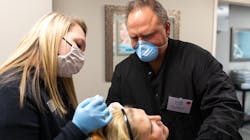Sustaining profitability during a pandemic
The COVID-19 pandemic has changed dentistry forever. The question is, have you changed? Did you learn any lessons from the pandemic on how to reposition your practice and your career? Can you withstand future recessions and assaults on the profitability of your practice?
According to the American Dental Association Health Policy Institute (HPI), the end of 2020 saw 80% of dentists reporting less patient volume, with 50% of dental practices experiencing a 25% or greater reduction in patient volume. 82.4% of dentists reported less total volume collections with 55.7% showing a 25% or more decrease in total collections.1 By contrast, American Academy of Facial Esthetics (AAFE) members who use injectables in their practice maintained anywhere from 97%–110% of their total volume collections for 2020 even with an average shutdown of eight weeks.2
Where do you fall in these statistics? Events of the past year certainly require dental practices to do some soul searching if we want to stay in the business of providing the best possible treatment and care for our patients, keep employing our wonderful team members, and take care of ourselves and our families. It is time to take a serious look at how to integrate stronger profitability strategies to ensure long-term growth and sustainability. Let me make one thing clear: strategies for profitability are much different from the cost-cutting measures many dental offices had to endure just to survive during the worst of the pandemic. We are looking for strategies we can institute immediately, after proper planning, that will be effective in helping us achieve our goals long term.
Square one
First, evaluate the services you provide and identify the most and least profitable. Treatment services profitability and return on investment (ROI) are made up of these three things:
- Cost of goods: What is the direct cost of the materials, lab fee (if applicable) delivered?
- Time involvement: This is the most overlooked item when it comes to determining profitability. We have only a finite amount of hours in the office. Those services which can be delivered to the highest standard in less time will be the most profitable to your bottom line.
- Fixed overhead: This is a main area which should be constantly addressed that is beyond the scope of this article. From a profitability aspect, your fixed overhead costs affect all of your services, especially when it comes to time involvement. The longer a procedure takes, the more direct fixed overhead is attributed to its profitability.
Most dentists have no idea which of their procedures are profitable and which are not. This is one of the most important pieces of business knowledge you need to know about your practice right now. For all you know, your practice is losing money on the procedures you are delivering the most! You know that beautiful MOD composite resin you did on tooth number 19? You spent 50 minutes delivering this restoration for a fee of $400. Do you think that was profitable? You most likely didn’t even cover the fixed overhead on that procedure, much less the cost of goods.
The path to profitability
The path to profitability increases when you can deliver your existing services faster, easier, and better than ever before. Those procedures that are time efficient are by far the most profitable. This depends on the procedure itself and your ability to deliver the best treatment outcomes.
Here are two great examples:
Implant dentistry: Every dental practice should be delivering single-tooth implant dentistry. In the past, the high cost of implant parts, high lab bills, and high time involvement (two appointments involving 2–3 hours, total) drastically reduced profitability. Make this more profitable by finding more reasonably priced lab services (Glidewell Dental Labs) and high-quality implants (Hahn Implants). As you become more experienced, the time involvement will dramatically improve, making implant services a highly profitable service in your practice.
Facial esthetic dentistry: Botox, dermal fillers, and solid filler polydioxanone (PDO) threads, in addition to being the most popular patient procedures, by far have the highest ROI and profitability of any dental treatment. The patient fee compared to cost of goods for Botox and fillers is anywhere from 1.5–3x while time involvement ranges from 5–15 minutes once properly trained. This can typically result in a profit of between $300–$1,500 for a 15-minute treatment. There is nothing else in dentistry that comes close to this profitability equation. To give you a profitability perspective, AAFE member Dr. Grace Chung had this observation: “I often will treat a patient for Botox in the few minutes that I am waiting for a crown and bridge impression to set, and I will be more profitable in that five minutes compared to the entire crown procedure.”
Recession-proof
Here is the flip side to the devastating statistics quoted above that patient volume and total collections are down more than 25% for dentists delivering dental services. According to an AAFE member study ending January 15, 2021, more than 94% of dentists who had integrated Botox, dermal fillers, and PDO threads into their practice before the pandemic ended 2020 with equal or more profitability year over year, even after pandemic closures of two months.2 That goes to show how profitability in individual services can directly affect the success of your practice and make your practice recession-proof. Botox, dermal fillers, and PDO threads are must-have services for every dental practice.
Here’s a funny story from my own practice to show you the popularity of Botox. We had patients who would not come in for their routine hygiene appointments, citing COVID-19 worries as an excuse. COVID concerns were not an issue for these same patients when they were due for their next Botox appointment.
I encourage you to take action, especially during this trying time that may be with us longer than we would like.
REFERENCES
- COVID-19 Economic Impact – State Dashboard. American Dental Association. https://www.ada.org/en/science-research/health-policy-institute/covid-19-dentists-economic-impact/survey-results
- AAFE member survey. Unpublished data. January 2021.
About the Author

Louis Malcmacher, DDS, MAGD
Louis Malcmacher, DDS, MAGD, is a practicing general dentist and an internationally known lecturer and author. He is the president of the American Academy of Facial Esthetics (AAFE). You can contact him at (800) 952-0521 or [email protected]. Go to facialesthetics.org for information about live-patient Botox and dermal fillers training, solid-filler PDO thread lifts, frontline TMJ and orofacial pain training, dental sleep medicine, bruxism therapy and medical insurance, and to sign up for a free monthly e-newsletter.

